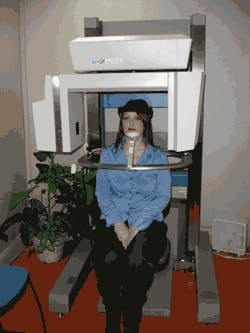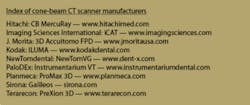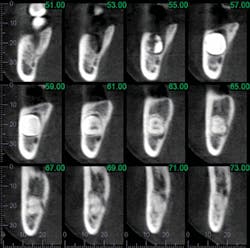by Joel Rosenlicht, DMD
As implant dentistry continues to grow in popularity with both practitioners and patients, it’s increasingly clear the treatment modality is driven largely by advances in diagnostic technology that help make the procedure safer and more successful for a greater range of patients. Despite all the surveys and studies showing that aging Baby Boomers are fueling much of the growth in implant dentistry, in my view this demand is the direct result of major technological advances that have made implants an attractive option for anyone seeking to replace missing teeth.
I believe the combination of advances in diagnostic imaging technology and exciting research and discoveries in bone augmentation have made implants one of the safest and most predictable procedures in dentistry. With the Baby Boomer generation aging and becoming more susceptible to periodontal disease and tooth loss, I expect a continued and unprecedented demand for implants in the next 10 to 15 years. The good news is that we can satisfy that demand with ultra-precise, high-quality procedures.
The view from two dimensions
Diagnostics is the key to successful implant placement. When I began practicing in the 1970s, implant dentists relied on two-dimensional radiographic images and clinical experience. As a result, the surgery was a touchy-feely process in which we made assumptions - sometimes guesses - about the quality and density of underlying bone. Radiographs often would lead us to do procedures we wouldn’t attempt today.
Radiation exposure also was a major disadvantage of X-rays. It is well known that excessive radiation exposure from X-rays increases cancer risk, and it’s critical that we do what we can to minimize patient exposure to radiation. There often was a difficult balance to maintain when seeking diagnostic information required for clinical decisions, while trying to minimize patient exposure to potentially harmful radiation. This assessment is based on studies showing that tissues in the head, neck, and mouth could be more susceptible to radiation than in other areas of the body.
In the old days, the bone assessment capability of X-rays was limited to pictures showing bone height with nothing to guide the dentist on width, density, or ability to support an implant. That was a major limitation of the two-dimensional image for planning implant surgery. We had to proceed with incomplete knowledge of the patient’s bone status and, for many, it meant undergoing bone-augmentation surgery to make sure an implant would survive. Also, lack of depth perception with a two-dimensional image made it difficult for dentists to judge proper implant length to avoid touching nerves, blood vessels, and sinuses - they simply cannot provide the whole anatomical truth.
The view from three dimensions is much better
Perhaps the most dramatic practice improvement attributable to state-of-the-art digital imaging vs. two-dimensional slides is that we can analyze the anatomy of the patient’s jaw without surgery, which saves time and money and shortens implant recovery time. It’s like having the patient’s jaw on the computer screen. I was fortunate to be one of the early users of cone-beam CT scanners. This technology allows me to more precisely decide which patients are candidates for immediate-load implants and also identify those who legitimately need aggressive bone augmentation procedures prior to implant placement.
I don’t believe there is a more significant technological development in the practice of implant dentistry and dental radiography than the cone-beam CT scanner. It has revolutionized the area. While the advantages of CT scans in dentistry have been well known for many years, the increasing availability of cone-beam units in dentists’ offices has made this technology more practical and affordable. Further, patients no longer have to endure annoying waits for appointments at hospitals or free-standing medical imaging centers for CT scans.
To appreciate the benefits of cone-beam technology for successful implant placement, we must understand the advantages of CT imaging at every step of the implant procedure - from the initial evaluation to the attachment of the crown. Three-D imaging has eliminated all the touchy-feely estimations of bone density. That is proving to be an understatement.
My noted colleague in Miami, Michael Pikos, DDS, spoke at the most recent annual meeting of the American Academy of Implant Dentistry. He reported in a plenary session that cone-beam CT scanning “has revolutionized the way I look at things” when assessing bone deficiency in implant patients. He said cone-beam CT gives the anatomic truth on exact bone deficiency and lets the implant surgeon decide how much autologous, donor, or synthetic bone material will be needed for a successful implant. I share his enthusiasm and add that cone-beam CT scanning soon will be a logical step in implant dentistry.
In my opinion, the diagnostic accuracy is so good, that we can do many more flapless procedures and spare patients from surgical incision trauma and the ever-present risks of swelling and infection. Even patients with bone deficiencies are eligible for flapless procedures and immediate-loading implants. The modality allows us to determine how the surgery should be performed and pick and choose which patients are the right candidates for various procedures. We don’t have to push the envelope, for example, regarding immediate-load implants and patients who insist on them. The technology doesn’t lie. We have objective, highly accurate images that show our patients, on the computer screen, how their bone stability governs the choice of the implant procedure that is best for them and assures the highest probability for long-term success.
Fan-beam vs. cone-beam CT
CT scanners produce outstanding image quality for overall resolution and spatial contrast. The images are very clear and distortion-free. They give life-like, three-dimensional images and provide excellent information regarding the density of bone and the cortical plate, as well as the anatomy of the jaw. Another key advantage is the dentist can rotate and manipulate the 3-D image on the computer screen to examine a target area in the jaw from every angle in fine detail.
Conventional CT scanners use a fan beam. Its spiral radiation pattern provides information in a continuous series of “slices” that enlarge targeted sites in the body. The machines are huge and impractical for use in a dental office. The cone-beam scanner, however, was designed for in-office use (see photo at right). These machines use pinpoint, cone-shaped radiation instead of a fan beam, and are ideal for examining small areas in the head and neck. The average scan time is about 20 seconds, and the patient must remain completely still while the image is being taken.
Designed for dental offices, the cone-beam CT scanner fits in a small space.
Now that you’re convinced it’s time to investigate acquiring a cone-beam CT scanner at an average cost of $150,000, let’s review a typical patient scenario in which you can put your new technology to excellent use.
Implant dentistry the digital way
The first step with every implant patient is an initial consultation to determine if implants are the appropriate treatment to replace missing or compromised teeth. Once the patient and doctor agree to proceed with treatment, initial CT scans are taken. Several decisions can be made from the cone-beam images, such as where the implant should be placed, what size it should be, and whether the bone density is sufficient at the desired site to support the implant. Also, the doctor learns exact locations of nerves, sinuses, and other sensitive facial structures.
But the key advantage today with cone-beam CT technology is that implant dentists can make prompt and confident decisions about bone augmentation. Previously, the surgeon often would drill and insert implants wherever he could find adequate bone by feel, experience, or X-ray. There was no resource available to determine in advance if the desired site was strong enough to withstand biting pressure. The cross-sectional view from a cone-beam CT provides lifelike images that guide decisions about bone quality, implant size, and angulation. The software does it all.
Once the desired implant locations have been identified and decisions about bone status have been resolved, the implant dentist can proceed in converting cone-beam diagnostic images into a surgical-placement guide. With most CT systems, there are software programs to generate a detailed analysis for planning an implant procedure. For example, the plan will show the location and path of alveolar nerves and warn the dentist if a chosen placement site is too close.
A cone-beam CT scan of an impacted third molar and aveolar bone showing various viewing angles.
Implant-planning software also allows the dentist to manipulate a CT image to look at various options for implant types, insertion angles, and depths. The bottom line is that technology advances are providing both diagnostic and implant-planning information that enables the surgery to be scripted in advance in exquisite detail. To further enhance precision, some implant systems enable dentists to order acrylic surgical drill guides that are custom-produced for each patient from the computer-generated implant map. The guides are placed on specific locations on the gum or bone, and the dentist can drill through the guides highly confident of being in the right position. CT data also can be used to construct life-size acrylic models that enable the dentist to literally rehearse the implant procedure.
Technology must benefit patients
What does all of this impressive technology mean for our patients? Above all, it means they can be confident that their investments in dental implants will achieve permanent restoration of one or more missing teeth. In most cases, implants and crowns look better than original teeth. Further, thanks to imaging technology advances, this has become the most dependable and standardized procedure in dentistry. Precise implant planning lets patients see how they will look, with no disappointments or surprises after surgery.
For the dentist, the investment in a cone-beam CT and implant-planning software helps ensure the procedure is right for every patient. Also, investing time for training, such as the American Academy of Implant Dentistry’s program (www.aaid.com), is a must for becoming proficient at implant dentistry.
I have performed a variety of implant procedures in numerous ways to address the needs of my patients. One patient comes to mind who had six implants and an immediate restoration in just one hour. The entire surgery was planned in precise detail in advance. Another patient came in with a broken tooth but the root was healthy. She left the office with an implant and her same crown, which we were able to repair. These examples would not have been possible without the information from cone-beam CT technology that allowed for immediate treatment and very satisfied patients.
Another advantage for dentists is vivid 3-D images of the entire head and neck that can be formatted in any way desired. As a result, we’re readily picking up on more abnormalities and problems in the underlying anatomy, such as sinus and nasal disorders, than ever before. It’s my belief that cone-beam CT soon will be the premier way for evaluating patients, not only for dental implants, but for a wide variety of bony pathologies and tissue problems.
Finally, we are now doing implant prodedures that were frowned upon years ago. This trend will continue as we live though the most exciting time in the history of implant dentistry. New technology has changed my practice and is helping to make implants a mainstream dental procedure. Naturally, cone-beam CTs are valuable for other procedures, but they are revolutionizing implant dentistry. I am able to help patients every day to regain a healthy smile, restore personal confidence, and achieve a better quality of life. And that’s what being an implant dentist is all about.Joel Rosenlicht, DDS, is an oral surgeon practicing in Manchester, Conn. Dr. Rosenlicht currently serves as treasurer of the American Academy of Implant Dentistry and vice president of the American College of Oral and Maxillofacial Surgeons. He is a diplomate of the American Board of Oral and Maxillofacial Surgeons as well as the American Board of Implantology/Implant Dentistry. He may be reached at (860) 649-2272 or visit [email protected].
Index of cone-beam CT scanner manufacturers
- Hitachi: CB MercuRay - www.hitachimed.com
- Imaging Sciences International: iCAT - www.imagingsciences.com
- J. Morita: 3D Accuitomo FPD - www.jmoritausa.com
- Kodak: ILUMA - www.kodakdental.com
- NewTomdental: NewTomVG - www.dent-x.com
- PaloDEx: Instrumentarium VT - www.instrumentariumdental.com
- Planmeca: ProMax 3D - www.planmeca.com
- Sirona: Galileos - sirona.com
- Terarecon: PreXion 3D - www.terarecon.com









